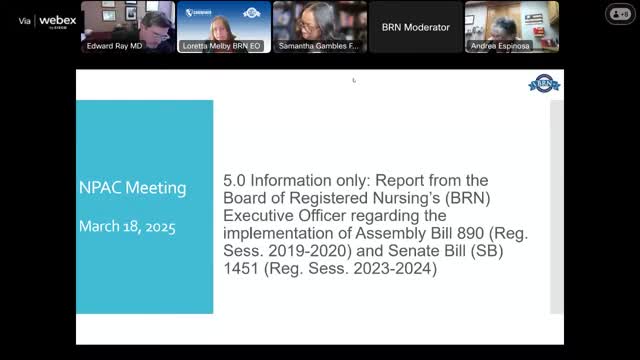California updates nurse practitioner practice requirements under SB 1451 legislation
March 19, 2025 | California Board of Registered Nursing, Boards and Commissions, Executive, California
Thanks to Scribe from Workplace AI and Family Portal , all articles about California are free for you to enjoy throughout 2025!

This article was created by AI using a video recording of the meeting. It summarizes the key points discussed, but for full details and context, please refer to the video of the full meeting. Link to Full Meeting
One of the most notable changes discussed was the elimination of the requirement that the provider who attests to a nurse practitioner's transition to practice must be in the same specialty area. Previously, a pediatric nurse practitioner, for example, was required to complete their transition by providing care exclusively to pediatric patients, with a pediatrician co-signing their attestation. This requirement has been lifted under Senate Bill 1451, allowing NPs to transition in any practice area, provided they work in a group setting with at least one physician.
This legislative shift raises important questions about the competencies of nurse practitioners and the potential impact on patient care. While the law allows for greater flexibility in practice areas, concerns were voiced regarding the implications for public safety and the quality of care. Some committee members expressed apprehension that this change could lead to NPs practicing in specialties without adequate training or oversight, potentially compromising patient safety.
The discussion also touched on the distinction between the roles of NPs operating under standardized procedures and those transitioning to independent practice. While NPs in group settings are still required to demonstrate competence based on their training and experience, the broader scope of practice could lead to NPs working in areas where they may not have sufficient expertise. This concern was particularly emphasized in relation to specialties like rheumatology, where the complexity of care requires a high level of training.
In response to these concerns, it was noted that the law mandates NPs to establish referral plans for complex medical cases, ensuring that they consult with other healthcare providers when necessary. However, some committee members questioned the effectiveness of these referral plans in safeguarding public health, particularly if NPs are allowed to operate independently in specialty areas without stringent competency assessments.
The meeting concluded with a recognition of the ongoing need for regulatory updates to align with the new statutory changes. While the Board of Registered Nursing is tasked with implementing these laws, the discussions underscored the importance of maintaining high standards of care and ensuring that nurse practitioners are adequately prepared to meet the needs of their patients.
As California continues to navigate these changes, the implications for healthcare access, particularly in underserved areas, remain a critical focus. The balance between expanding practice opportunities for nurse practitioners and ensuring patient safety will be pivotal in shaping the future of healthcare delivery in the state.
Converted from Nurse Practitioner Advisory Committee 1 pm. meeting on March 19, 2025
Link to Full Meeting
Comments
View full meeting
This article is based on a recent meeting—watch the full video and explore the complete transcript for deeper insights into the discussion.
View full meeting
